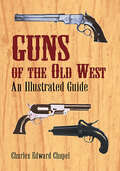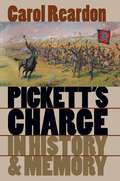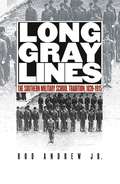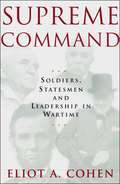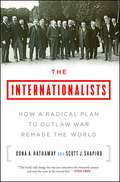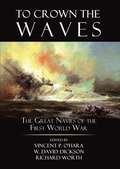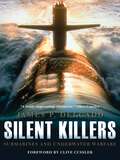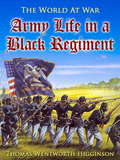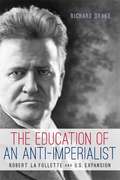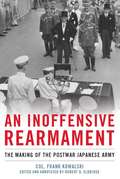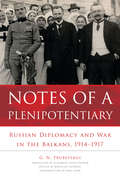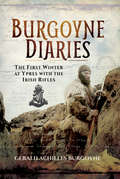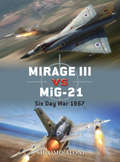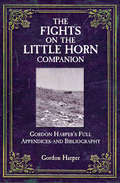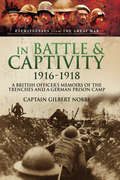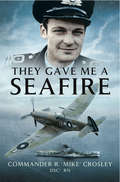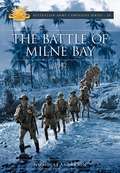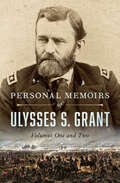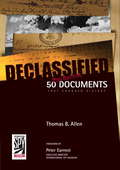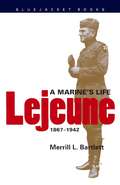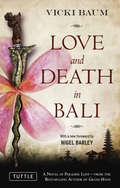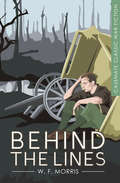- Table View
- List View
Guns of the Old West: An Illustrated Guide (Dover Military History, Weapons, Armor)
by Charles Edward ChapelFirearms played an important role on the American frontier. Used to hunt animals for food and clothing, they also safeguarded one’s home against outlaws and other hostile elements. This definitive, scrupulously researched work describes and illustrates the many different weapons that opened up and secured the American West. Enhanced with colorful anecdotes, the vividly detailed narrative tells the dramatic story of shoulder arms, hand guns, percussion and cartridge weapons, and describes the hunters, settlers, peace officers, stagecoach drivers, soldiers, range detectives, rustlers, outlaws, Indian chiefs, and other picturesque characters who used them.Here are detailed descriptions and illustrations of the Kentucky rifle that saw battle in the American Revolution and in the War of 1812; the repeating rifle used in the Civil War; the Sharps rifle that wreaked havoc during the great buffalo hunts; the Colt revolver, used by cowboys and outlaws alike; the fast and reliable Winchester rifle, the most widely used shoulder arm of the post-Civil War era; as well as flintlock pistols, derringers, muskets, buffalo guns, carbines, signal pistols, Confederate revolvers, and many other celebrated firearms.Illustrated with nearly 500 photographs and line illustrations, this classic reference will not only be invaluable to dealers and collectors but will also appeal to Americana devotees, weaponry enthusiasts, and students of the American West.
Pickett's Charge in History and Memory
by Carol ReardonIf, as many have argued, the Civil War is the most crucial moment in our national life and Gettysburg its turning point, then the climax of the climax, the central moment of our history, must be Pickett's Charge. But as Carol Reardon notes, the Civil War saw many other daring assaults and stout defenses. Why, then, is it Pickett's Charge at Gettysburg--and not, for example, Richardson's Charge at Antietam or Humphreys's Assault at Fredericksburg--that looms so large in the popular imagination? As this innovative study reveals, by examining the events of 3 July 1863 through the selective and evocative lens of 'memory' we can learn much about why Pickett's Charge endures so strongly in the American imagination. Over the years, soldiers, journalists, veterans, politicians, orators, artists, poets, and educators, Northerners and Southerners alike, shaped, revised, and even sacrificed the 'history' of the charge to create 'memories' that met ever-shifting needs and deeply felt values. Reardon shows that the story told today of Pickett's Charge is really an amalgam of history and memory. The evolution of that mix, she concludes, tells us much about how we come to understand our nation's past."A fresh look at the disastrous assault.--New Yorker"A splendidly lively study of the manipulation, not necessarily deliberate or malign, of public opinion.--Atlantic Monthly"Exceptionally lucid. . . . This fine book provides vivid evidence of just how far we will go to alchemize fantasy into fact.--Jonathan Yardley, Washington Post"Well-written and meticulously researched, Pickett's Charge in History and Memory utilizes first-rate scholarship to tell a fascinating story. . . . Should win a wide audience among general readers.--Civil War HistoryAssessing the myths and facts surrounding Pickett's Charge, Carol Reardon explores why this event endures so strongly in the American imagination. She demonstrates that the story told today of the charge is really an amalgam of history and memory and that the evolution of that mix tells us much about how we come to understand our nation's past.-->
Pickett’s Charge, July 3 and Beyond, Omnibus E-book
by Earl J. Hess Carol ReardonPickett's Charge, the assault on the Union lines on Cemetery Ridge ordered by Robert E. Lee on 3 July 1863, the last day of the Battle of Gettysburg, holds a central place in the nation's collective memory of the Civil War. Available for the first time as an Omnibus E-book Edition, this two-volume set provides readers with an integrated view of the Charge, from the battlefield to the American imagination. The Omnibus comprises Earl J. Hess's Pickett's Charge: The Last Attack at Gettysburg, a detailed and authoritative account of the Charge itself, and Carol Reardon's Pickett's Charge in History and Memory, which provides the rest of the story: how, and why, Pickett's Charge became so singularly important to our national memory of the Civil War.In Pickett's Charge: The Last Attack at Gettysburg, Hess offers the definitive history of the most famous military action of the Civil War. He transforms exhaustive research into a moving narrative account of the assault from both Union and Confederate perspectives, analyzing its planning, execution, aftermath, and legacy. most famous military action of the Civil War. He transforms exhaustive research into a moving narrative account of the assault from both Union and Confederate perspectives, analyzing its planning, execution, aftermath, and legacy.In Pickett's Charge in History and Memory, Reardon examines the events of 3 July 1863 through the selective and evocative lens of 'memory' and reveals that we can learn much about why it endures so strongly in the American imagination. Over the years, soldiers, journalists, veterans, politicians, orators, artists, poets, and educators, Northerners and Southerners alike, shaped, revised, and even sacrificed the 'history' of the charge to create 'memories' that met ever-shifting needs and deeply felt values. Reardon shows that the story told today of Pickett's Charge is really an amalgam of history and memory. The evolution of that mix, she concludes, tells us much about how we come to understand our nation's past.
Long Gray Lines
by Rod AndrewMilitary training was a prominent feature of higher education across the nineteenth-century South. Virginia Military Institute and the Citadel, as well as land-grant schools such as Texas A&M, Auburn, and Clemson, organized themselves on a military basis, requiring their male students to wear uniforms, join a corps of cadets, and subject themselves to constant military discipline. Several southern black colleges also adopted a military approach. Challenging assumptions about a distinctive "southern military tradition," Rod Andrew demonstrates that southern military schools were less concerned with preparing young men for actual combat than with instilling in their students broader values of honor, patriotism, civic duty, and virtue. Southerners had a remarkable tendency to reconcile militarism with republicanism, Andrew says, and following the Civil War, the Lost Cause legend further strengthened the link in southerners' minds between military and civic virtue. Though traditionally black colleges faced struggles that white schools did not, notes Andrew, they were motivated by the same conviction that powered white military schools--the belief that a good soldier was by definition a good citizen. "[Long Gray Lines] is a valuable resource. It is well researched, well argued and thought provoking. . . . A useful work with important insights into a significant southern tradition.--Civil War Book Review"An important work that engages larger historical questions.--Journal of Military History "This provocative, highly original, and thoughtfully illustrated study is grounded in impressive research. . . . It invites us to rethink the southern military tradition.--Journal of Southern HistoryChallenging assumptions about a distinctive "southern military tradition," Rod Andrew demonstrates that southern military schools were less concerned with preparing young men for actual combat than with instilling in their students broader values of honor, patriotism, civic duty, and virtue. Southerners had a remarkable tendency to reconcile militarism with republicanism, Andrew says, and following the Civil War, the Lost Cause legend further strengthened the link in southerners' minds between military and civic virtue. -->
Supreme Command: Soldiers, Statesmen and Leadership in Wartime
by Eliot A. CohenThe relationship between military leaders and political leaders has always been a complicated one, especially in times of war. When the chips are down, who should run the show -- the politicians or the generals? In Supreme Command, Eliot Cohen examines four great democratic war statesmen -- Abraham Lincoln, Georges Clemenceau, Winston Churchill, and David Ben-Gurion -- to reveal the surprising answer: the politicians. Great states-men do not turn their wars over to their generals, and then stay out of their way. Great statesmen make better generals of their generals. They question and drive their military men, and at key times they overrule their advice. The generals may think they know how to win, but the statesmen are the ones who see the big picture. Lincoln, Clemenceau, Churchill, and Ben-Gurion led four very different kinds of democracy, under the most difficult circumstances imaginable. They came from four very different backgrounds -- backwoods lawyer, dueling French doctor, rogue aristocrat, and impoverished Jewish socialist.Yet they faced similar challenges, not least the possibility that their conduct of the war could bring about their fall from power. Each exhibited mastery of detail and fascination with technology. All four were great learners, who studied war as if it were their own profession, and in many ways mastered it as well as did their generals. All found themselves locked in conflict with military men. All four triumphed. Military men often dismiss politicians as meddlers, doves, or naifs. Yet military men make mistakes. The art of a great leader is to push his subordinates to achieve great things. The lessons of the book apply not just to President Bush and other world leaders in the war on terrorism, but to anyone who faces extreme adversity at the head of a free organization -- including leaders and managers throughout the corporate world. The lessons of Supreme Command will be immediately apparent to all managers and leaders, as well as students of history.
Supreme Command
by Eliot A CohenThe relationship between military leaders and political leaders has always been a complicated one, especially in times of war. When the chips are down, who should run the show -- the politicians or the generals? In Supreme Command, Eliot Cohen examines four great democratic war statesmen -- Abraham Lincoln, Georges Clemenceau, Winston Churchill, and David Ben-Gurion -- to reveal the surprising answer: the politicians. Great states-men do not turn their wars over to their generals, and then stay out of their way. Great statesmen make better generals of their generals. They question and drive their military men, and at key times they overrule their advice. The generals may think they know how to win, but the statesmen are the ones who see the big picture. Lincoln, Clemenceau, Churchill, and Ben-Gurion led four very different kinds of democracy, under the most difficult circumstances imaginable. They came from four very different backgrounds -- backwoods lawyer, dueling French doctor, rogue aristocrat, and impoverished Jewish socialist.Yet they faced similar challenges, not least the possibility that their conduct of the war could bring about their fall from power. Each exhibited mastery of detail and fascination with technology. All four were great learners, who studied war as if it were their own profession, and in many ways mastered it as well as did their generals. All found themselves locked in conflict with military men. All four triumphed. Military men often dismiss politicians as meddlers, doves, or naifs. Yet military men make mistakes. The art of a great leader is to push his subordinates to achieve great things. The lessons of the book apply not just to President Bush and other world leaders in the war on terrorism, but to anyone who faces extreme adversity at the head of a free organization -- including leaders and managers throughout the corporate world. The lessons of Supreme Command will be immediately apparent to all managers and leaders, as well as students of history.
The Internationalists: How a Radical Plan to Outlaw War Remade the World
by Scott J. Shapiro Oona A. HathawayA bold and provocative history of the men who fought to outlaw war and how an often overlooked treaty signed in 1928 was among the most transformative events in modern history.On a hot summer afternoon in 1928, the leaders of the world assembled in Paris to outlaw war. Within the year, the treaty signed that day, known as the Peace Pact, had been ratified by nearly every state in the world. War, for the first time in history, had become illegal the world over. But the promise of that summer day was fleeting. Within a decade of its signing, each state that had gathered in Paris to renounce war was at war. And in the century that followed, the Peace Pact was dismissed as an act of folly and an unmistakable failure. This book argues that that understanding is inaccurate, and that the Peace Pact ushered in a sustained march toward peace that lasts to this day. The Internationalists tells the story of the Peace Pact by placing it in the long history of international law from the seventeenth century through the present, tracing this rich history through a fascinating and diverse array of lawyers, politicians and intellectuals—Hugo Grotius, Nishi Amane, Salmon Levinson, James Shotwell, Sumner Welles, Carl Schmitt, Hersch Lauterpacht, and Sayyid Qutb. It tells of a centuries-long struggle of ideas over the role of war in a just world order. It details the brutal world of conflict the Peace Pact helped extinguish, and the subsequent era where tariffs and sanctions take the place of tanks and gunships. The Internationalists examines with renewed appreciation an international system that has outlawed wars of aggression and brought unprecedented stability to the world map. Accessible and gripping, this book will change the way we view the history of the twentieth century—and how we must work together to protect the global order the internationalists fought to make possible.
To Crown the Waves
by W. David Dickson Vincent P. Ohara Richard WorthThe only comparative analysis available of the great navies of World War I, this work studies the Royal Navy of the United Kingdom, the German Kaiserliche Marine, the United States Navy, the French Marine Nationale, the Italian Regia Marina, the Austro-Hungarian Kaiserliche und Königliche Kriegsmarine, and the Imperial Russian Navy to demonstrate why the war was won, not in the trenches, but upon the waves. It explains why these seven fleets fought the way they did and why the war at sea did not develop as the admiralties and politicians of 1914 expected.After discussing each navy's goals and circumstances and how their individual characteristics impacted the way they fought, the authors deliver a side-by-side analysis of the conflict's fleets, with each chapter covering a single navy. Parallel chapter structures assure consistent coverage of each fleet-history, training, organization, doctrine, materiel, and operations-and allow readers to easily compare information among the various navies. The book clearly demonstrates how the naval war was a collision of 19th century concepts with 20th century weapons that fostered unprecedented development within each navy and sparked the evolution of the submarine and aircraft carrier. The work is free from the national bias that infects so many other books on World War I navies. As they pioneer new ways of viewing the conflict, the authors provide insights and material that would otherwise require a massive library and mastery of multiple languages. Such a study has special relevance today as 20th-century navies struggle to adapt to 21st-century technologies.
Silent Killers: Submarines and Underwater Warfare
by James DelgadoJames P Delgado, President and CEO of the Institute of Nautical Archaeology and author of Nuclear Dawn (Osprey), presents a detailed, stunningly visual, examination of the history and development of the submarine and its role in naval warfare, from the first practical experiments with submersible craft to the development of the modern nuclear submarine. Calling on his training as a nautical archaeologist who was among the first explorers to dive the Titanic, Delgado recreates the story of the sub from the bottom up--that is, through eerie photographs of subs at the bottom of the sea. In addition, he explores submarine technology, from wooden to iron to steel hulls, from hand-cranked to nuclear powered propulsion, from candle light to electricity, from gunpowder "torpedoes" to nuclear missiles Since the time of Jules Verne, submarines have been a topic of great interest to maritime and military fans and Delgado's new book explores all of the submarine's triumphs and tragedies, successes and failures in this fascinating and compelling illustrated history.
Army Life in a Black Regiment (The World At War)
by Thomas Wentworth HigginsonThomas Wentworth Higginson (December 22, 1823 – May 9, 1911) was an American Unitarian minister, author, abolitionist, and soldier. He was active in the American Abolitionism movement during the 1840s and 1850s, identifying himself with disunion and militant abolitionism. He was a member of the Secret Six who supported John Brown. During the Civil War, he served as colonel of the 1st South Carolina Volunteers, the first federally authorised black regiment, from 1862–1864. Following the war, Higginson devoted much of the rest of his life to fighting for the rights of freed slaves, women and other disfranchised peoples. (Excerpt from Wikipedia)
The Education of an Anti-Imperialist
by Richard DrakeRobert M. La Follette (1855-1925), the Republican senator from Wisconsin, is best known as a key architect of American Progressivism and as a fiery advocate for liberal politics in the domestic sphere. But "Fighting Bob" did not immediately come to a progressive stance on foreign affairs. In "The Education of an Anti-Imperialist," Richard Drake follows La Follette's growth as a critic of America's wars and the policies that led to them. He began his political career with conventional Republican views of the era on foreign policy, avidly supporting the Spanish-American and Philippine-American Wars. La Follette's critique of empire emerged in 1910, during the first year of the Mexican Revolution, as he began to perceive a Washington-Wall Street alliance in the United States' dealings with Mexico. La Follette subsequently became Congress's foremost critic of Woodrow Wilson, fiercely opposing United States involvement in World War I. Denounced in the American press as the most dangerous man in the country, he became hated and vilified by many but beloved and admired by others. La Follette believed that financial imperialism and its necessary instrument, militarism, caused modern wars. He contended they were twin evils that would have ruinous consequences for the United States and its citizens in the twentieth century and beyond.
An Inoffensive Rearmament
by Robert D. Eldridge Frank KowalskiColonel Frank Kowalski served as the Chief of Staff of the American military advisory group that helped establish the National Police Reserve, the predecessor to the Japan Self-Defense Forces, and provided daily guidance to it during its first two years of existence. In this book, Kowalski provides, with great care, a detailed account of the manning, logistics, and personalities involved in standing up, on short notice, of a force of approximately 75,000, while sharing insights about the diplomatic, political, legal, and constitutional challenges his headquarters and his Japanese counterparts faced in navigating this new course for Japan in the wake of the sudden outbreak of war on the Korean Peninsula in June 1950. In light of these limitations, the path for rearmament had to be slow and "inoffensive" while psychologically and materially contributing to Japan's defense. His account is balanced, a blend of both criticism and praise, of all of those involved, including himself. Kowalski, who later served in Congress, was a highly intelligent Army officer who was expecting to be deployed to Korea in the summer of 1950, after serving in local military governments in western Japan, when he was tapped for the above secret mission to make a new Japanese army while having to call it a police reserve. An honorable man, he was pained by the subterfuge he and his government, working hand in hand with the Japanese government, had to play in order to establish this needed organization and believes many things were mishandled, but also viewed the "quiet and reasonable approach" of the rearmament program as successful and allowing the NPR to "adequately and effectively" provide for the urgent defense needs of the Japan and the United States, with its quarter million dependents left to fend for themselves in Japan in 1950. Kowalski notes that there has always been a tension in the postwar U.S.-Japan relationship over Japan not doing enough to contribute to the bilateral alliance and international security. This book will not end that debate, but it provides greater context and historical understanding of what factors existed at the time. This is a particularly important topic as Japan is re-examining its defense posture today, both for its own needs as well as to strengthen its still complicated relationship with the United States, its only alliance partner. Written in the mid-1960s, and published in Japanese in 1969, this is the first time this edited book has appeared in English.
Notes of a Plenipotentiary: Russian Diplomacy and War in the Balkans, 1914–1917 (NIU Series in Slavic, East European, and Eurasian Studies)
by G. N. TrubetskoiA prince in one of Russia's most exalted noble families, Grigorii N. Trubetskoi was a unique and contradictory figure during World War I. A lifelong civil servant and publicist, he began his diplomatic career in Constantinople, where he served as first secretary of the embassy there for several years. He became one of the leaders of an important political orientation among the liberals that began to express opposition to the tsar, not only on questions of political freedom and domestic political reform, but also by criticizing the tsar's foreign policy on nationalistic grounds. Trubetskoi possessed significant influence over Russian foreign policy and was instrumental in pushing the regime toward an aggressive annexationist stand in the Balkans. When the Russian ambassador to Serbia died suddenly in June of 1914, Trubetskoi was appointed as his replacement—situating him at the center of Russian diplomacy during the decisive period of Russia's entry into the war. His account of this period serves as an important reference for the study of the war's outbreak. Trubetskoi also discusses how he drafted the proclamation on Poland and gives a revealing account of its origins. A valuable source on the major historical problem of the entry of Turkey into the war, the narrative provides interesting details about agreements with Britain and France. Translated by Trubetskoi's granddaughter, Elizabeth Saika-Voivod, and featuring Trubetskoi's original photographs, this fascinating memoir provides an inside look at Russian foreign policies during crucial points of the war. It will appeal to scholars, students, and general readers interested in World War I and Russian history.
The Burgoyne Diaries: The First Winter at Ypres with the Irish Rifles
by Gerald Achilles BurgoyneThese are the diaries of Gerald Achilles Burgoyne, wrote from the trenches just south of Ypres while he was with the Royal Irish Rifles in the Great War.The author's daughter, Claudia Davison, was not even born when these diaries were originally written and was only 12-years-old when her father died in 1936 after being bombed by the Italian Air Force while he and his mules were conveying a Red Cross unit in Ethiopia.Claudia found the diaries in a trunk full of personal effects when her mother died and, after showing them to a long-standing friend who loved the diaries, she sent them off to be published.Despite conditions of all-pervading mud, bitter cold and wind, let alone the bursting shells and the 'sipping' bullet, Burgoyne dispassionately recorded and drew what he saw. These vivid accounts, written on pages of a notebook, were almost daily sent back to his wife. Each day is a gem of interest, from the very first entry in November 1914 to the last in May 1915.The diaries end as abruptly as they begin. In May 1915 Burgoyne was wounded and sent back to England after a gruesome and abortive attack on the notorious Hill 60.Complete with maps and sketches drawn by Burgoyne at the time, this book is essential reading for all Great War enthusiasts and those wishing to learn more about the key conflicts that occurred in 1914 and 1915.
Mirage III vs MiG-21
by Shlomo Aloni Jim LaurierAlthough the opposing forces of the Six Day War were both flying comparable third-generation Mach 2 jet fighters, the pilots were trained to different standards, and were expected to utilize different tactics. Using the latest research, first-hand accounts, and specially commissioned artwork, Shlomo Aloni tells the dramatic story of the dogfights in the skies over the Middle East.
The Fights on the Little Horn Companion: Gordon Harper's Full Appendices and Bibliography
by Gordon HarperA treasury of sources and supplemental information for readers of the award-winning history The Fights on the Little Horn. This volume collects and lists books, booklets, pamphlets, manuscripts, personal and family papers, newspapers, magazines, periodicals, correspondence, interviews, military and historical journals, military and government reports, and more used by Gordon Harper, author of The Fights on the Little Horn, in his extraordinary years-long research into Custer&’s Last Stand. As a companion volume to that book, or a resource for anyone interested in the history of the American West, it is a valuable and comprehensive guide.
In Battle & Captivity, 1916-1918: A British Officer's Memoirs of the Trenches and a German Prison Camp (Eyewitnesses from The Great War)
by Captain Gilbert NobbsInitially published in 1917 under the title On the Right of the British Line, this is the first book written by the extraordinary Captain Gilbert Nobbs. Dedicated to his ever loving wife, the harrowing memories and experiences of Nobbs at the Battle of the Somme and after are captured here in a rare account of what proved to be one of the most ultimately futile battles and the agonising aftermath.Following his journey from the fields of the Somme into German custody, In Battle & Captivity 1916-1918 provides an unflinching report of the dramatic losses felt during the horrific Battle of the Somme. However, the book manages to maintain a message of hope that, despite experiencing the barbarity of German captivity, there can still be happiness, as Nobbs proclaimed, 'I do not deplore the loss of my sight, for I can say in all sincerity that I was never happier in my life than I am today.'During the Somme Offensive he led his company in an assault on the German trenches and sustained a shot to the head, which left him permanently blind when the bullet exited through his right eye. Grievously wounded, Nobbs lay undiscovered in a shell-hole as the battle raged round him. After two days he was found and awoke to find himself in a German hospital. Once his wounds had been treated Nobbs was sent to a POW camp where he remained for three months. Fortunately, one month later the truth was discovered, and in December 1916, Nobbs returned to England, where his home, wife and family awaited him. This is the astonishing autobiographical account of Henry Gilbert Nobbs, an extraordinary man of inexhaustible energy whose memoirs will forever provide one of life's enduring monuments to the human spirit.
They Gave Me a Seafire
by Commander R. "Mike" Crosley&“Superb . . . one of the most honest, candid, and truly delightful memoirs . . . the perfect memorial to one of the Fleet Air Arm&’s greats.&”—Aircrew Book Review A classic in every sense of the word, this book charts Commander R. &“Mike&” Crosley&’s service career in the Fleet Air Arm during the entire period of the Second World War. Part of his service saw him in action aboard HMS Eagle, flying Sea Hurricanes on the Harpoon and Pedestal Malta convoys of June and August 1942. It was during this time that he shot down his first enemy aircraft and survived the dramatic sinking of HMS Eagle. From there he graduated on to Seafires, (the Naval equivalent of the Spitfire), and flew this type in Combat Air Patrols over Norway and ramrod strikes from Operation Torch (the invasion of French North Africa in November 1942), through to D-Day in June 1944 in the European Theatre of Operations, and then in the Pacific abroad HMS Implacable as part of the British Pacific Fleet in 1945 until the end of the Pacific War, by which time he had command of his own combined squadron, 801 and 880. They Gave Me a Seafire sets to bring the endeavors of Crosley to a whole new generation of enthusiasts, and it should appeal across the board to fans of aviation, naval history and families and friends of Armed Forces, past and present. &“The fascinating publication details Mike&’s incredible capacity for survival, and sheer skill as a pilot, which were remarked on at the time, securing him a number of decorations.&”—Island Life Magazine
The Battle of Milne Bay 1942 (Australian Army Campaigns Series #24)
by Nicholas AndersonBy 1942 the formidable Japanese military had conquered swathes of territory across south-east Asia and the Pacific Ocean. Despite its defeat at the Battle of Midway, Japan remained a potent enemy committed to the creation of a defensive arc to shield its captured possessions in the Pacific. The capture of Port Moresby would cement the southern border of this defensive arc and sever the vital lines of communication between Australia and the United States. It was the Japanese plan to seize Moresby that would set the course for the Battle of Milne Bay. Situated on the eastern tip of New Guinea, Milne Bay was a wretched hell-hole: swamp-riddled, a haven for malaria and cursed with torrential rain. It was here that General Douglas MacArthur ordered the secret construction of an Allied base with airfields to protect the maritime approach to Port Moresby. But the Japanese soon discovered the base at Milne Bay and despatched a task force to destroy its garrison and occupy the base. All that stood between the Japanese and their prize was a brigade of regular Australian soldiers untrained in tropical warfare and a brigade of Australian militia with no combat experience whatsoever. While the Kokoda campaign is etched in public memory, its sister battle at Milne Bay has long been neglected. However the bitter fighting over this isolated harbour played an equally important role in protecting Port Moresby and made a valuable contribution to shifting Allied fortunes in the Pacific War.
Personal Memoirs of Ulysses S. Grant: Volumes One and Two (Barnes And Noble Library Of Essential Reading)
by Ulysses S. GrantThe celebrated remembrances of the man who led the Union to victory during the Civil WarCompleted just days before his death, Grant&’s Personal Memoirs is a clear and compelling account of his military career, focusing on two great conflicts: the Mexican-American War and the Civil War. Lauded for its crisp and direct prose, Grant&’s autobiography offers frank insight into everything from the merits of the war with Mexico to the strategies and tactics employed by Union forces against the Confederacy to the poignancy of Grant&’s meeting with General Lee at Appomattox Court House.Beloved and bestselling since its publication in 1885, Personal Memoirs of Ulysses S. Grant is a seminal work of military history and one of the great achievements of American autobiography.This ebook has been professionally proofread to ensure accuracy and readability on all devices.
Declassified: 50 Top-Secret Documents That Changed History
by Thomas B. AllenCulled from archives around the world, the 50 documents in Declassified illuminate the secret and often inaccessible stories of agents, espionage, and behind-the-scenes events that played critical roles in American history. Moving through time from Elizabethan England to the Cold War and beyond, noted author Tom Allen places each document in its historical and cultural context, sharing the quirky and little-known truths behind state secrets and clandestine operations. Each of seven chapters centers on one particular theme: secrets of war, the art of the double cross, spy vs. spy, espionage accidents, and more. Through support and access provided by the International Spy Museum in Washington, D.C., this lively history contains never-before-published and hard-to-find documents, printed from scans of the originals wherever possible. These include The Zimmerman Telegram, which led America into World War I; letters from Robert Hanssen to his Soviet spymaster, marking the start of his devastating career as a mole; and papers as recent as the Presidential Daily Brief that announced that Bin Laden was determined to strike the U.S., delivered in August 2001.
Lejeune
by Merrill L. BartlettThis well-documented and hard-hitting biography of the thirteenth commandant of the U.S. Marine Corps succeeds in converting John A. Lejeune from a near mythical figure in corps history to a flesh and blood officer who helped build the service from a small appendage of the U.S. Navy to an important arm of naval warfare.Commandant from 1920 to 1929, when he retired from military service to become president of Virginia Military Institute, Major General Lejeune is regarded by many as the man most responsible for the establishment of the modern Marine Corps. In capturing the life and times of this visionary leader who directed the corps toward major amphibious operations, Merrill Bartlett provides vivid insight into the political and military giants of the era and shows Lejeune to be an adroit player of Washington politics and a shrewd manipulator who marshalled the energies and loyalties of his senior officers to accomplish his vision
Love and Death in Bali
by Nigel Barley Vicki BaumSet against the backdrop of the Dutch invasion of Bali just over a century ago, and the resulting "mass suicides" of the Balinese royalty, the moving story unfolds of the peasant Pak and his family and friends, and the tragedy that is their shared fate.Written within living memory of the bloody events called the puputan (the "ending"), Love and Death in Bali is the story of a passionate yet peaceful and deeply spiritual people who defy the Dutch imperial forces through an act that would bring them certain death--and certain rebirth.The looting of a Chinese trading ship gives the Dutch colonial forces the perfect excuse to intervene in island affairs, but they encounter astonishing resistance. In the battle of Badung, wave upon wave of Balinese clothed in white ceremonial garb charged into the blazing Dutch guns, kris daggers in hand, prepared to die. Who among them will survive, and how will their lives be forever changed?Love and Death in Bali, first published in German in 1937, is considered by many to be the finest novel ever written about this island paradise where everyone, regardless of caste of position, is woven into the fabric of an ancient culture.
Love and Death in Bali
by Nigel Barley Vicki BaumSet against the backdrop of the Dutch invasion of Bali just over a century ago, and the resulting "mass suicides" of the Balinese royalty, Love and Death in Bali uses the tales of ordinary people to tell the bloody story of the conquest and subjugation of an island paradise.
Behind the Lines: A Novel (Casemate Classic War Fiction #6)
by W. F. MorrisAfter killing a fellow officer, a British World War I fighter joins the ranks of deserters and outlaws in a suspenseful novel from the author of Bretherton.Behind the Lines follows army man Peter Rawley, who accidentally kills an overbearing, taunting fellow officer and, terrified that he will not receive a fair hearing amid the chaos of the trenches, flees the battlefield. Now a fugitive, Rawley must join forces with other deserters, criminals, and lost soldiers in a hand-to-mouth existence, trying to survive in the no-man's-land between opposing armies. He will encounter both adventure and disaster, including capture by the Germans and the threat of a firing squad--and will need to call upon his own bravery and the support of the woman he loves to survive. A thriller from the author of Bretherton: Khaki or Field-Grey?--which was praised by the Sunday Times as "a mystery as exciting as a good detective story and an extraordinarily vivid account of trench-warfare"--this is a meditation on the issues of identity and allegiance, as well as the role of chance. Behind the Lines is a classic of WWI fiction and an exciting read that brings the drama of the Great War to life.
